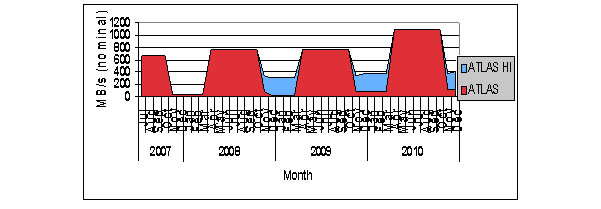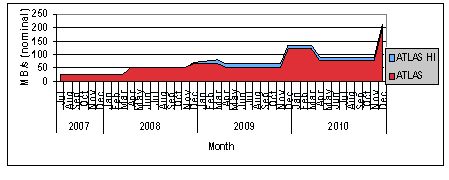   |  |
Computing Technical Design Report
The required bandwidth out of CERN is essentially set by the migration of data to the external Tier-1 facilities. There is a need for semi-immediate (real time) transfer of data offsite.
It should be noted that the future cost evolution for bandwidth depends on many external factors. Thus far, we have benefited from uncharged access to bandwidth provided under external funding. It is hoped that this continues, but as we are dependent on bandwidth, we are carrying a large potential source of financial risk.
The traffic is based on the planned flow of RAW, ESD and AOD data from CERN to the Tier-1; this is assumed to be direct point-to-point. As there are expected to be distinct data-taking periods for p-p and heavy ions running, the nominal aggregate bandwidth is given in the two cases in Table 7-3 and Table 7-4 respectively.
A projection of the likely time profile of the nominal traffic between Tiers is given by Figure 7-5-Figure 7-7. All of the quoted bandwidths correspond to the rate aggregated over the month, with no efficiency or other factors applied. At the least, some additional capacity will be needed for the peak load and `catch-up' situations.
A very high networking requirement between CERN and the Tier-1 cloud is indicated. There is also a high bandwidth required between each Tier-1 and the rest of the Tier-1 cloud. The precise bandwidth required depends on the network topology assumed to link the Tier-1s; some routing options may also imply substantial fast disk buffers in the system.
Table 7-3 The decomposition of the traffic for pp data between CERN and an average-sized Tier-1 in 2008-2009.
Table 7-4 The decomposition of the aggregate nominal bandwidth for heavy ions data between CERN and an average heavy-ions Tier-1 in 2008-2009.

|
An estimate has also been made of the ATLAS-only traffic between the Tier-1 facilities; this is comprised of the copying of `back-up' samples from another Tier-1 for the various data processing versions. It also includes the transfer of analysis-group derived datasets. The actual traffic from other sources, such as the data flow associated with job submission is not included, but believed to be relatively small. Naturally, factors for efficiency of bandwidth usage and contention need to be added. The aggregate nominal bandwidth required for 2008 is given in Table 7-5, while the projected time profile is given in Figure 7-6.
Table 7-5 The decomposition of the Tier-1 to Tier-1 traffic for an average sized Tier-1 in 2008-2009.

|
The bandwidth required between a Tier-1 and Tier-2s will depend very much on the size of the Tier-2s concerned, but in terms of the files to be made available for general use at each Tier-2 it will be typically below 10 MB/s. The traffic associated with user jobs is again not included, and may well be the dominant term in this case. However, estimates of the expected traffic between an average Tier-1 and its associated cloud of three Tier-2s have been made; the projected time profile of the nominal aggregate traffic is given in Figure 7-7.

|
Remote Event Filter processing is not considered in this baseline model, but if it is to occur then a significant additional bandwidth upwards from 10 Gb/s will be needed between the ATLAS pit and the remote site, the actual capacity required depending on the Event Filter load displaced.
   |  |
Copyright © CERN 2005